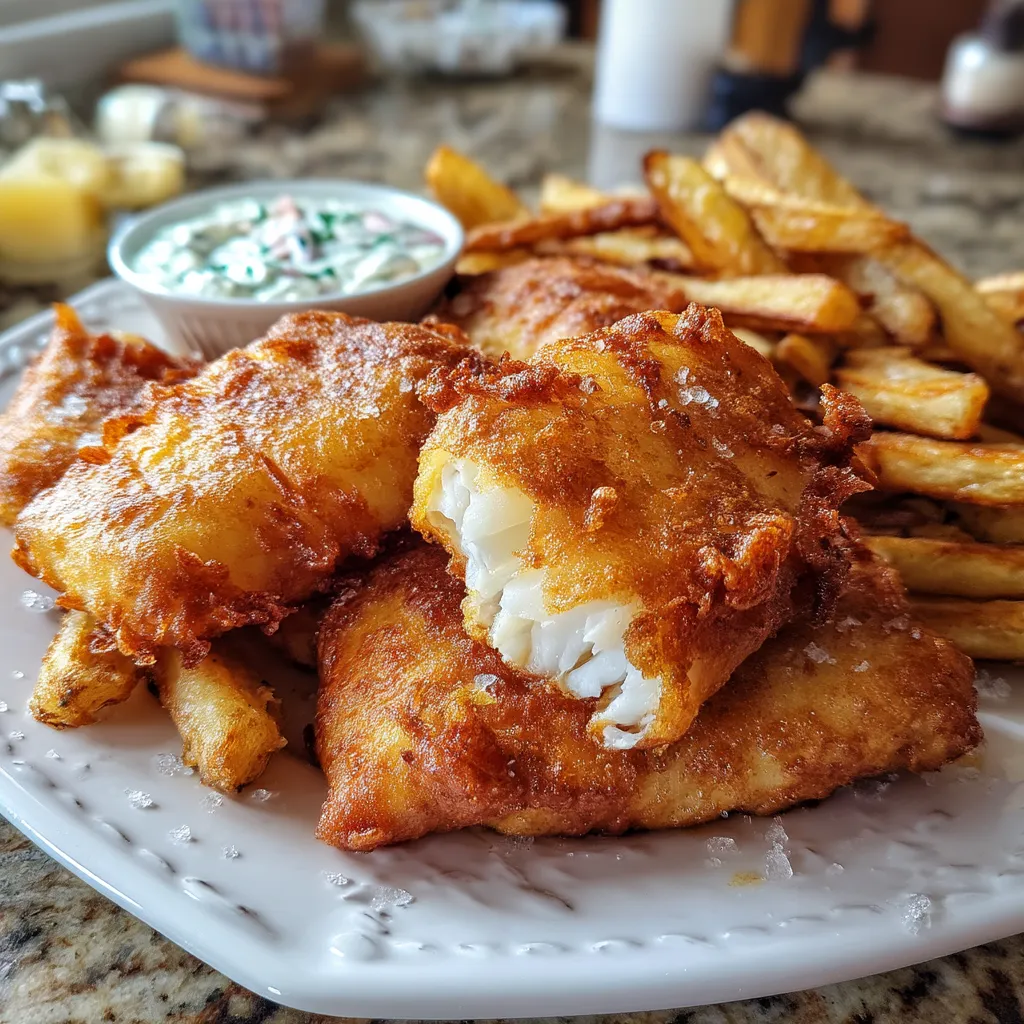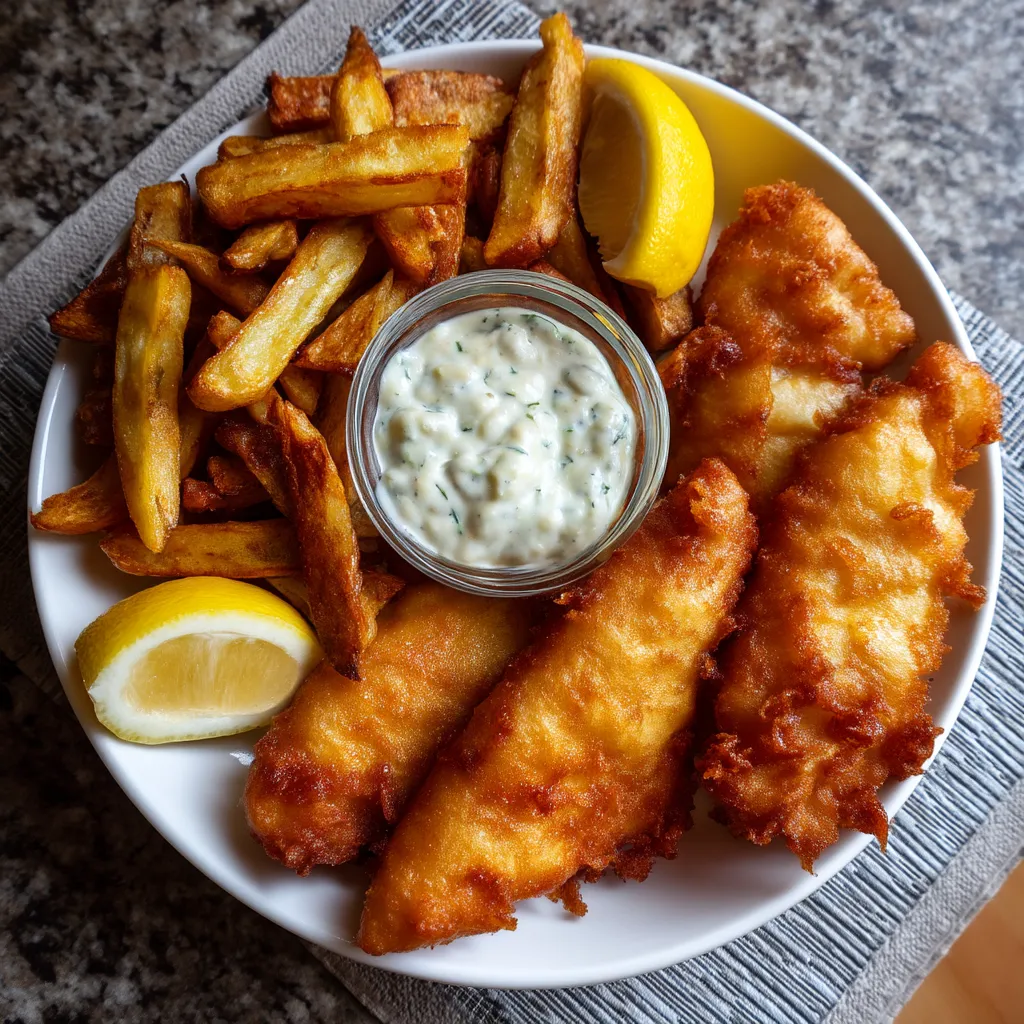 Save It
Save It This golden, crispy beer-battered fish and chips recipe brings the authentic British pub experience straight to your kitchen. The combination of flaky white fish in a light, airy beer batter paired with double-fried chips creates that perfect contrast of textures that makes this dish an enduring classic.
I perfected this recipe after a trip to London where I became obsessed with finding that perfect crisp-to-tender ratio. After many test batches and oil-splattered kitchens, this version now makes regular appearances for our Friday family dinners.
Ingredients
- White fish fillets: such as cod, haddock, or pollock. Fresh, thick-cut fillets work best as they stay moist while frying
- All-purpose flour: for dredging creates the base that helps the batter adhere properly
- Salt and pepper: enhance the natural sweetness of the fish
- All-purpose flour: provides structure to the coating
- Cornstarch: creates that light, crispy texture that shatters perfectly when bitten
- Baking powder: adds air pockets for a lighter, less dense batter
- Cold lager or ale: is essential. The carbonation and yeast create an airy texture while adding subtle flavor
- Salt and pepper: season the batter thoroughly
- Russet potatoes: offer the perfect starch content for crispy exteriors and fluffy interiors
- Vegetable oil: with a high smoke point ensures proper frying without burning
- Sea salt: finishes the chips with that essential savory bite
Step-by-Step Instructions
- Prepare the Potatoes:
- Soak cut potatoes in cold water for at least 30 minutes to remove excess starch. This step is crucial for achieving crispy fries. After soaking, drain thoroughly and pat completely dry with paper towels. Any remaining moisture will cause dangerous oil splatters.
- First Fry for Chips:
- Heat oil to precisely 325°F. This lower temperature cooks the potatoes through without browning them. Work in small batches to avoid overcrowding which would lower the oil temperature. Fry for 3 to 4 minutes until the potatoes are soft but not yet colored. Remove and drain thoroughly on paper towels. Let them cool completely before the second fry.
- Second Fry for Chips:
- Increase oil temperature to 375°F. This higher temperature creates the crispy exterior. Return cooled potatoes to oil in small batches and fry until deeply golden and crisp, about 2 to 3 minutes. Listen for the sizzle to quiet down which indicates moisture has been removed. Drain and season immediately with sea salt while still hot.
- Prepare the Fish:
- Pat fish pieces completely dry with paper towels. Moisture prevents the batter from adhering properly. Season lightly with salt and pepper on both sides. Dredge in flour and shake off excess until just a thin, even coating remains.
- Mix the Batter:
- In a large bowl, whisk together the dry ingredients first to ensure even distribution. Pour in cold beer all at once and whisk quickly until smooth. Some small lumps are fine. The batter should have the consistency of pancake batter. If too thick, add a splash more beer.
- Batter and Fry:
- Working quickly, dip each floured fish piece into the batter. Hold above the bowl momentarily to let excess drip off. Carefully lower into 375°F oil away from you to prevent splashing. Cook in batches of 2 pieces at a time for 4 to 6 minutes until deeply golden. Flip halfway through if fish isn't fully submerged.
- Serve:
- Drain fish on paper towels briefly. Serve immediately while everything is at peak crispness with lemon wedges, tartar sauce, and malt vinegar if desired.
 Save It
Save It One secret I discovered is keeping the beer ice-cold until the moment you make the batter. This keeps the carbonation active and slows gluten development, resulting in the signature light and crispy coating that makes this dish special. My husband now brings home different craft beers for us to experiment with in the batter, which has become a fun way to make each batch unique.
The Perfect Batter Technique
The secret to achieving that ideal light and crispy batter lies in temperature control and minimal handling. Always use cold beer straight from the refrigerator and let your batter rest for just 5 minutes before using. This allows the gluten to relax slightly while keeping the carbonation active. Never overmix your batter as this develops too much gluten, resulting in a tough coating instead of that delicate crunch we want. The consistency should be just thick enough to coat the back of a spoon while still slowly dripping off.
Choosing the Right Fish
While cod is the traditional choice for fish and chips, several alternatives work beautifully in this recipe. Look for thick fillets with firm, white flesh and mild flavor. Haddock offers a slightly sweeter taste than cod with similar texture. Pollock is more sustainable and budget-friendly while still providing excellent results. Whatever fish you choose, freshness is key. The fish should smell clean like the ocean, never fishy, and the flesh should be firm and spring back when pressed.
Serving Suggestions
In Britain, authentic fish and chips often comes wrapped in newspaper with specific accompaniments. Create the full experience by serving with classic sides like mushy peas, which provide a lovely color contrast and complementary flavor. A small side of coleslaw adds freshness to cut through the richness. For condiments, tartar sauce is essential, but also consider curry sauce, a popular option in modern British chip shops. Serve everything family-style on a large platter with plenty of lemon wedges and malt vinegar for guests to customize.
 Save It
Save It Common Questions About Recipes
- → What's the best type of fish to use?
Cod, haddock, and pollock work best as they have firm, white flesh that holds together well during frying. These mild-flavored fish complement the beer batter without overpowering it. Halibut is another excellent but pricier option.
- → Why does the recipe call for soaking and double-frying the potatoes?
Soaking removes excess starch, preventing the chips from sticking together. The double-frying technique creates the perfect texture—first at a lower temperature to cook the interior, then at a higher temperature to create a crispy exterior while maintaining a fluffy center.
- → Can I use non-alcoholic beer for the batter?
Yes, non-alcoholic beer works well and provides similar flavor. The carbonation in beer creates air bubbles that make the batter light and crispy. If avoiding beer entirely, club soda or seltzer water can substitute, though the flavor profile will be slightly different.
- → What's the ideal oil temperature for frying fish?
375°F (190°C) is the ideal temperature for frying fish. Too low and the batter absorbs oil and becomes soggy; too high and the outside burns before the fish cooks through. Using a kitchen thermometer ensures the perfect temperature throughout the cooking process.
- → How can I keep everything hot when serving?
Keep finished chips and fish warm in a 250°F (120°C) oven on a wire rack over a baking sheet. This maintains crispness better than covering with foil, which traps steam and softens the coating. Serve immediately once everything is ready for the best texture and taste.
- → How do I know when the fish is fully cooked?
The fish is done when the batter is golden brown and crispy, about 4-6 minutes depending on thickness. When flaked with a fork, the fish should be opaque and easily separate. For thicker pieces, you can check that the internal temperature reaches 145°F (63°C).